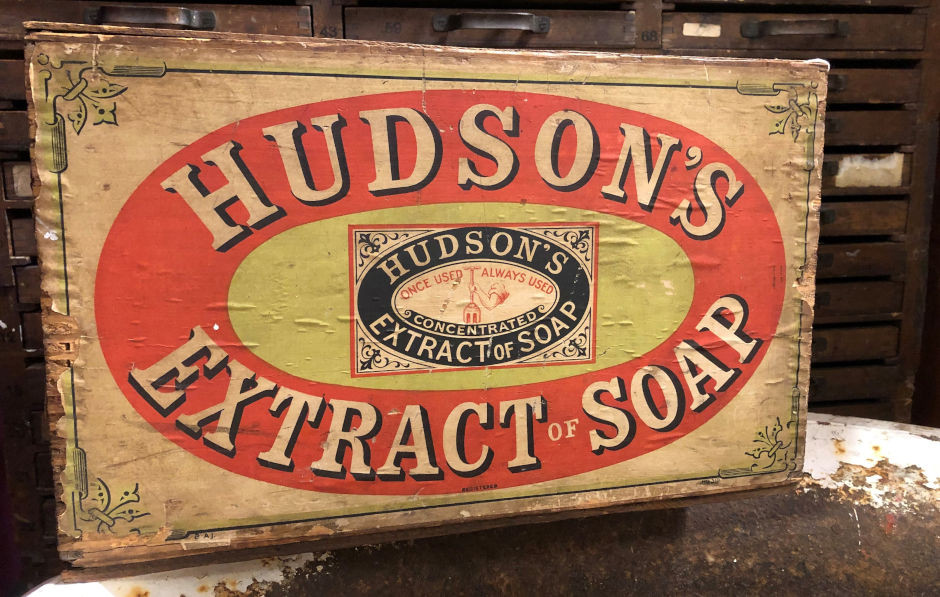
Ever since the Ancient Egyptians who advertised wares for sale on papyrus signs, or the town criers of the Middle Ages who notified the crowds of upcoming markets, goods have been bought and sold and those goods have been advertised.
Advertising collectables represent an interesting, niche area and encompass so much more than the enamel signs that people associate with this area of collecting (see our blog on vintage enamel signs). But why exactly is this such a popular area for collectors? And what types of object can you collect?
The market for vintage advertising collectables relies heavily on nostalgia and can transport us back to childhood or a happier time as quickly as a familiar scent or taste. It is no surprise then, that in the modern world, where we all live our lives at breakneck speed, any items that can take us back to ‘better’ days are becoming more and more sought after. Simply put, advertising memorabilia preserves a slice of history for the collector, delivering a taste of a bygone era, and its enduring appeal is easy to understand.
Beyond vintage signs, there are plenty of other vintage advertising memorabilia for collectors to choose from and most will choose a type of product e.g. calendars, a particular area e.g. motor vehicles, a definite era e.g. the 1930s, or even a specific company e.g. Michelin. Here are just some of the areas of advertising collectables that are popular:
Beer mats
The first beer mats were manufactured in the 1880s in Dresden as a means to protect ale from insects. These early cardboard mats were superseded by mats made from wood pulp that were designed to absorb the overflow and condensation from a glass. As with most paper ephemera, the beer mats were meant to be throw away items but their cheap production costs made them popular with breweries who realised that they would make a great advertising medium. However, it wasn’t until 1922 that the first mats were produced by an English brewery. The British Beermat Collectors Society was formed in 1960, with the comedy duo, Morecambe and Wise becoming the society’s first presidents.
Biscuit tins
Favoured by early European voyagers thanks to their long shelf life, biscuits were not presented in decorative, metal tins until 1832. These first hand made containers were produced by the son of Joseph Huntley, the founder of the Huntley and Palmer biscuit makers. Although there were other names of note in biscuit manufacturing, including McVitie’s and Peek Frean, it is the name of Huntley and Palmer which has become synonymous with biscuit tin collectables. Initially used as a tool to advertise the brand and gain brand awareness, the tins began to take on more ornate shapes and novelty themes such as cottages and buses, as the company became widely associated with their products. In 2019, a Huntley and Palmer tin in the shape of a London bus, dating from the late 1920s, was valued between £1000-£1500.
Tobacco tins
Sir Francis Drake introduced tobacco to England in 1573 and within just 40 years, there were more than 7,000 tobacco shops in the capital alone. Tin advertising boxes were first used for snuff, with the first tinned branded tobacco products appearing in 1770.
Interestingly, with tobacco tins, the age of the item is less important than with other collectables. The design of the tin will affect value, however, with the most sought after examples having attractive designs in strong colours. As with all areas of collecting, condition of the tobacco tin is paramount. Look for tins with no missing print and colours that have retained their vibrancy without fading. Rust, dents and scratches should be at a minimum and the finish of the tin should retain its shine.
Matchboxes
Phillumeny is the hobby of collecting match-related items including matchboxes and matchbooks, among other things, and the match, or friction match, that is used today is widely accepted to be the invention of a Stockton chemist, John Walker, who recorded his first sale in 1827.
In the UK, The British Matchbox Label and Bookmatch Society was founded in 1945 as The British Matchbox Label and Booklet Society and today advises on all aspects of this niche area of collectables. There are a number of types of matchbox label (and it is the label that is collected, rather than the box), which include single top labels (a single square glued to one side), all-round labels (wrapped around the entire box), and skillets (the matchbox we are familiar with today where the label is printed onto the box). Additionally, people also collect packet size labels which would have enveloped a packet of 10-12 boxes, and matchbook covers, which are usually collected without the matches, unless they have an image printed on the matchsticks.
Coca Cola
Where collectors specialise in a particular company, the best example to illustrate this is in the case of Coca Cola. Acknowledged as a master of mass advertising, the iconic Coca Cola branding and associated images can be found on items as diverse as posters, glassware, clocks, fridges, Christmas ornaments, vending machines and even thermometers! The original logo was created in 1886 and bar a few changes, it remains as instantly recognisable today as it was then.
Whether you are an existing collector, or are considering starting a collection, finding sellers who specialise in your area of interest will be key. Our dealers at Hemswell offer customers a wealth of experience and their collections encompass a wide range of items. Once current lockdown restrictions are eased, a visit to our centres is a trip not to be missed; you will be able to browse at your leisure, taking your time to explore each of our buildings. Until then, our Advertising Collectables are available to view online.